Just as one’s heart isn’t centered but is on the left side of one’s body, the Mosby Center is on the left side of South Ferry Road. The last building on the road that leads visitors to the Bay Campus, the small, unassuming “North Lab” as it was originally called, is the oldest building on the campus. Though it may not be as distinctive as the South Ferry Church perched on the hill, the Mosby Center still serves as a sentinel overlooking the Bay Campus beach, the research vessel at the dock, Narragansett Bay with all her complex ecosystems, and in the distance to the south, Rhode Island Sound, the passageway to the world’s oceans for our research vessels and scientists.
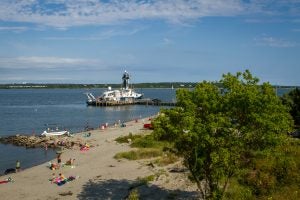
Early Research Studies
North Lab is where research for the Bay Campus had its start. Before there was the Knauss Quad surrounded by research buildings, before there was the Fish Building, before there was the research nuclear reactor, before there was the Environmental Protection Agency (EPA) or the National Marine Fisheries Service (NMFS), there was the North Lab.
Before there was the Graduate School of Oceanography (GSO) at the University of Rhode Island (URI), this community was known as the Narragansett Marine Lab of Rhode Island State College (see more details in a previous blog). When the first Lab Director Charles Fish and his wife and fellow researcher Marie Poland Fish arrived in 1936, there was still a small lab building near the shore and a larger stone building up the hill remaining from the days when South Ferry was a flourishing port, re-purposed as offices and the library. But the devastating hurricane of September 23, 1938 wiped out the lab.
Soon after that, the North Lab was built. It was constructed with a concrete slab in the middle of the floor to accommodate the weight of wet tables and freshwater and seawater tanks for research. Under the eaves, at either end of the building, was storage space for samples. There were stairs to an upper level platform where one could stand and access the storage space under the eaves at either end of the building. The Lab was the site of the campus’ research activity. There were two lengthy articles, in the September 10, 1950 and in the October 31, 1954 editions of “The Rhode Islander” section of the Providence Journal Sunday Journal Magazine, describing the various research topics studied at the lab: bioacoustics, plankton, quahogs, seastars, and bottom sediments.
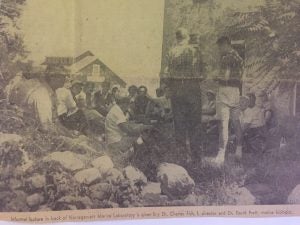
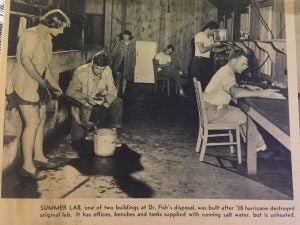
Pioneering Research on Bioacoustics
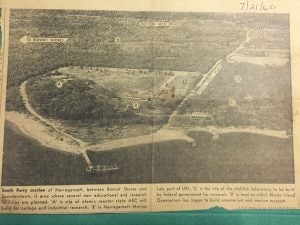
In January 1959, there was a serious electrical fire in the stone building. The contents (including reams of research notes and data) were destroyed and the stone remains had to be torn down. The faculty offices moved over to the North Lab, the only building remaining on campus. The Fish Building was built in 1960 and labs, offices, and the new library were quickly occupied. In 1961 GSO was officially established and accepted its first students for degree programs.
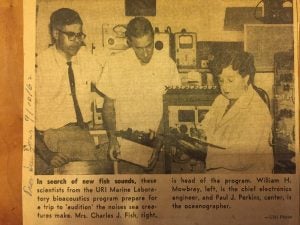
That was the situation when GSO student J. Lawrence (Larry) Dunn arrived in 1963 to be a student of Marie Fish. Their research took place in the North Lab, and it was a crowded, busy place. Much of the research focused on bioacoustics, Marie Fish’s specialty, and was funded by the National Defense Education Act because it was deemed work that “contributed to the national defense”.
In one study Larry helped out fellow grad student George Offutt with his research on the response of goldfish to sounds. George trained the fish to swim over a barrier when they heard a sound. He wanted to compare those results to how a human hears and Larry became that human (but instead of swimming, Larry indicated what he heard by hand). That work ended up as a published paper.
Larry relates a story showing the students’ resourcefulness in the North Lab: “The most exciting event I recall from those days was the great power blackout that occurred on November 9, 1965 and lasted many hours. The whole Northeast was affected. We had a lot of fish that were going to die if we didn’t do something. We put together a lot of scuba tanks and set up aeration sufficient to keep oxygen levels high enough to keep the fish alive until the power grid was squared away.”
In October of 1966 Larry was called up for the Navy, but that did not stop his bioacoustics research or end his connections to GSO since he was stationed in Washington D.C. in the Naval Oceanographic Office. One of his projects was a cruise on GSO’s research vessel the R/V Trident and he brought along Navy acoustic gear that improved the work they could do. They worked out of Newfoundland listening to whale sounds, mostly pilot whales. Another project was working from a big, four engine airplane, dropping sonobuoys into the ocean to record the “acoustic signature” of sperm whales so they would not be mistaken for submarines. This work was written up as an “Informal Report” of the Naval Oceanographic office and became Larry’s first published paper.
Later Larry went on to use his oceanography knowledge combined with a veterinary degree to care for marine mammals at the Mystic (CT) Aquarium and he continues to be a practicing vet with his own office in Charleston, RI. Marie Fish retired in 1966 but much of her work and her students’ work continued with GSO Professor Howard Winn and his work with marine mammals. At the time, GSO was “on the cutting edge of bioacoustics”, says Larry.
Fun fact: In addition to Charlie and Marie Fish and their daughter Marilyn who helped out with research in the summer in the North Lab, there was also (no relation) Nancy Fish who was Charlie’s secretary and her husband Jim Fish who was a graduate student at GSO. As Larry said, “There was always a veritable school of fishes moving about the building.”
Invertebrates, Forams, and Lunch
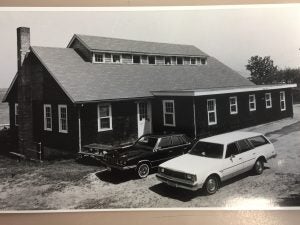
There was a one-story addition put on along the whole west side of North Lab and starting in the mid-1960’s other research took place here in the Annex. GSO professor Robert McMaster occupied part of it with a “sieve shaker” that separated different sizes of sediments for his Narragansett Bay bottom geology study.
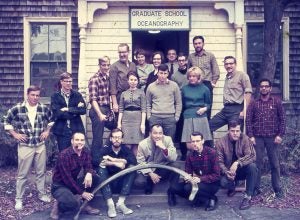
Sheldon Pratt, who had started at GSO in 1961 as a graduate student with Professor David Pratt (no relation), had several Army Corp of Engineer projects with Professor Saul Saila and needed space for counting and identifying marine invertebrates (small clams, worms, crabs, and similar animals) from sediments brought up from the bottom of the Bay or offshore, so he set up a lab in North Lab. His research often related to Rhode Island dredging studies. Another study was for the Argo Merchant oil spill, which was sampled in December 1976 on the maiden cruise of the R/V Endeavor. Sheldon had as many as four marine assistants working for him at once. These people (usually GSO or URI students) sat at lab benches under the windows on the west side of North Lab. Over the years, many people got their start in the marine field by working for Sheldon: Carol Price, Theresa Lyons, Mary Worobec, Christoper Deacutis, Anne Kuhn, Kathy McKenna, and Elliot Campbell. One student who worked for Sheldon was Jim Bisagni, who was also a student of Robert McMaster, so Jim spend a lot of time in North Lab. Sheldon’s office was in the southwest corner of North Lab.
With more people working there, the North Lab was quickly becoming where people ate lunch and conversed. Around the late 1960’s, lunch food was available for purchase for the first time. Mrs. Dwelly, whose husband Bill Dwelly ran the gas station on the way to Wickford (the station known as Babbie’s Texaco for those readers of a certain age), served food at the station and expanded to serving food at the North Lab. Sheldon reports that the food was “good quality, full of meat, and was satisfying home cooking.”
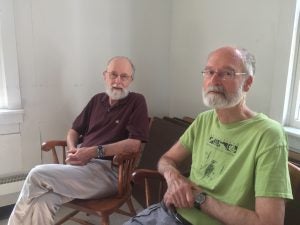
In 1976 one of Professor James Kennett’s students needed a quiet place to look at his geological foraminifera samples and write scientific papers on what he found . He found a good spot in the northwest corner of North Lab and set up a lab and office there. This student was Bruce Corliss. His office was the opposite end of the North Lab addition from Sheldon Pratt. Seeing each other on a daily basis for a couple of years, Sheldon and Bruce developed a fast friendship. Bruce graduated in February of 1978 and left for the Woods Hole Oceanographic Institution and later Duke University, but years later returned as Dean of GSO.
Dean Knauss’ Vision
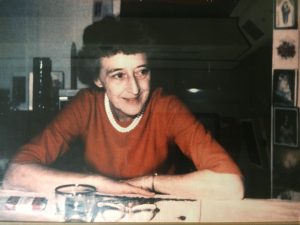
In the late 1960’s the Assistant to GSO Dean John Knauss was Helen J. Mosby, and he called her “the glue that holds this place together”. She was an active and well-liked member of the GSO community, known for her sense of humor and her kindness. She also stood up for what she believed in. She was the staff member that convinced John that pantsuits were acceptable attire for the Dean’s Office (the dress code then was dresses and skirts), by showing how professionally she could work while wearing one. Unfortunately, she became sick and passed away in 1970. On November 14, 1977 the North Lab was renamed the Helen J. Mosby Center in her honor.
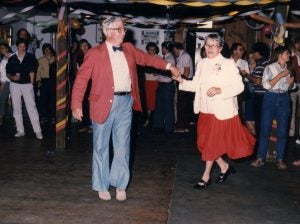
Over the years, other buildings were built on the Bay Campus and research programs moved out of North Lab. Probably the last to move out was Sheldon Pratt’s lab, which moved to the recently completed Aquarium Building (now the Ann Gall Durbin Aquarium Building) in late 1977. This allowed space to add a kitchen in the southwest side of the Mosby Center so it could become a full-time lunch room for all of the Bay Campus (including colleagues at the EPA and NMFS Labs). The Mosby Center hosted of a variety of GSO events, such as Dean Knauss’ 50th and other birthday parties, Eileen Hughes’ and other retirement parties, Halloween costume parties, GSO receptions for graduates, and a campus favorite, the GSO Holiday Party. The upper levels platforms, reached by stairs at either end of Mosby, were no longer needed for sample storage so were used as a perch for speeches and at holiday time, for Professor Saul Saila’s accordion playing and for speakers for dance music.
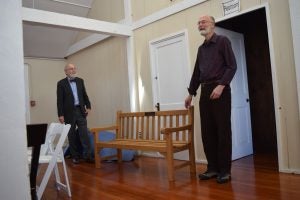
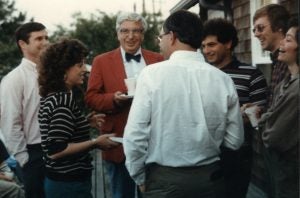
This fulfilled one of the visions of Dean Knauss, to have a place where all Bay Campus members could gather and talk and interact with each other. Dean Knauss himself often came here for lunch and sat wherever he could find someone to talk to. And having a place with a gorgeous view of the water is good for everyone. If only these walls could talk – the stories they could tell about the Bay Campus!
Mosby Center’s Rebirth
When the Ocean Science and Exploration Center (OSEC) was opened in 2009, the Nautilus Café opened and became the new lunch room. The Mosby Center was used for fewer events and fell into disrepair. When Bruce Corliss returned to GSO as Dean in 2013, one of the first places he visited was his old lab and office in North Lab/Mosby Center. The place wasn’t looking very good. This wasn’t right for a place that as Dean Corliss says, “was an important center of the Bay Campus for years.”
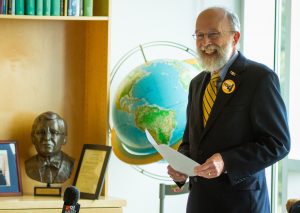
Over the past few years, with financial help from URI and private donors, the Mosby Center has had its floors refinished, its walls painted, as well as doors, windows, and the roof replaced. Next up in spring 2019 is a new deck, railings, and a bathroom that will all be compliant with the American with Disabilities Act. It’s important to do this because the Mosby Center “is important historically, is an important part of the Bay Campus, has wonderful ambience, and people really enjoy it and appreciate it for gatherings and social meetings” says Dean Corliss.
With these improvements, the North Lab/Mosby Center will soon be the heart of the Bay Campus once again.
December 6, 2018. Volume 1, Number 9
The author would like to thank J. Lawrence Dunn, Sheldon Pratt and Dean Bruce Corliss for agreeing to be interviewed for this blog. The information about Helen Mosby was found in “Anne Barrington’s Memoirs of GSO” in the Pell Library, GSO. Newspaper copies of articles and the older photos from the Providence Journal and Providence Evening Bulletin can be found in the scrapbook: “History of GSO, Fishes, Fire, and South Ferry Church” assembled by Joyce A. Downey, Coordinator of Library Services, and located in the Pell Library at GSO.
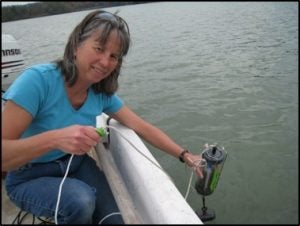 This blog post was written by Veronica M. Berounsky, GSO Science Correspondent and Coastal Ecologist. She first arrived at GSO in March of 1979 as a research lab tech. In 1990 she obtained her Ph.D., working on nitrification in Narragansett Bay with the late Scott W. Nixon. She continues to be fascinated by the ecology of coastal ecosystems every day. With this blog she hopes to increase your understanding of the activities and people of GSO and the Narragansett Bay Campus. Please email any comments to her at vmberounsky@uri.edu.
This blog post was written by Veronica M. Berounsky, GSO Science Correspondent and Coastal Ecologist. She first arrived at GSO in March of 1979 as a research lab tech. In 1990 she obtained her Ph.D., working on nitrification in Narragansett Bay with the late Scott W. Nixon. She continues to be fascinated by the ecology of coastal ecosystems every day. With this blog she hopes to increase your understanding of the activities and people of GSO and the Narragansett Bay Campus. Please email any comments to her at vmberounsky@uri.edu.
Click here to see all previous Bay Campus (B)logs.
Subscribe to the Bay Campus (B)log here
